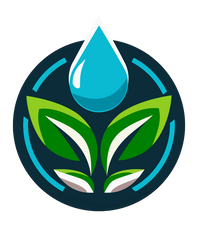Recommended Products
Welcome to UGrowFood
Your Gateway to Knowledge & Support for Hydroponic Farming in Your Home

Water Prep & Maintenance
The Lifeblood of, well... Everything
In hydroponic systems, or "Hybridponic" as Gardy calls it, water is the lifeblood of the plants. It's their sole source of food and nutrients. Although it's not the only factor influencing plant health and productivity, it's indispensable. Just like humans, plants require clean water to thrive and grow strong.
So, how does one procure clean water suitable for plant growth?
You might encounter a variety of...unique...suggestions regarding water treatment. In this guide, we'll demonstrate the process using a scientific approach backed by our three decades of experience in hydroponic farming.
Fear not, the explanation will be straightforward and simple to grasp. No complexities here. You'll learn an easily duplicable method for water preparation, perfect for systems like Gardyn. We aim to keep it as uncomplicated as possible.
Water sources for your system.
Hydroponic home growers have several water sources to choose from, each with its own characteristics and implications for plant health. City water, or tap water, is commonly used due to its easy accessibility. However, it often contains chlorine or chloramine, which can be harmful to plants. City water typically has a moderate hardness level, meaning it contains a balanced amount of dissolved minerals like calcium and magnesium. On the other hand, well water can vary significantly in hardness depending on the local geology. It often contains higher levels of minerals, making it “hard” water. Hard water can lead to nutrient imbalances in hydroponic systems, necessitating the use of a water softener to remove excess minerals.
When a water softener is used, it typically replaces calcium and magnesium ions with sodium or potassium ions. This process can make the water softer and more suitable for hydroponic use by preventing mineral buildup.
However, the increased sodium levels can be detrimental to some plants, so it’s crucial to monitor and adjust nutrient solutions accordingly. In contrast, city water, if treated properly to remove chlorine and chloramine, can be used directly without the need for a softener. This makes it a more straightforward option for many home growers, provided they address the initial chemical treatments.
Spring water is another potential source, but it comes with its own set of challenges. While it can be rich in natural minerals beneficial for plant growth, it is often bottled and processed, making it an expensive choice for regular use in hydroponics. Additionally, the mineral content can vary, requiring careful monitoring and adjustment of nutrient solutions. For most home growers, the cost and variability make spring water less practical compared to city or well water. In the next section, we’ll explore different types of filtration systems that can help optimize these water sources for hydroponic use.
Filtration
Activated Charcoal Filtering is a popular choice for hydroponic growers due to its ability to remove impurities and contaminants from water. This type of filtration works by adsorbing chemicals, chlorine, and organic compounds, resulting in cleaner water for your plants. Activated charcoal filters are relatively affordable and easy to maintain, making them a cost-effective option for home growers. The primary benefit for plants is the reduction of harmful substances that can inhibit growth or cause damage. However, activated charcoal does not remove dissolved minerals, so it won’t affect the hardness or softness of the water. This makes it a good option for those using city water or well water that doesn’t require mineral adjustment.
Here are examples of two types, Under the Sink and On the Faucet. Both offer the cleanliness you need without stripping minerals requiring an adjustment in your nutrients to maintain plant health.
Reverse Osmosis (RO) systems provide a high level of water purification by forcing water through a semi-permeable membrane, removing up to 99% of dissolved salts, minerals, and contaminants. This results in very pure water, which is ideal for hydroponic systems as it allows for precise control over nutrient solutions. RO systems can be more expensive upfront and require regular maintenance, but the benefits to plant health and growth can be significant. Using RO water means you start with a clean slate, free from impurities that could interfere with nutrient uptake. However, because RO water is stripped of all minerals, it is considered “soft” and may require the addition of calcium, magnesium, and other essential nutrients to ensure optimal plant growth.
Here is a tankless RO System that saves dramatically on waste water.
Nutrients
Veg+Bloom from Hydroponic Research is renowned for being a superior hydroponic plant nutrient due to its comprehensive and versatile formulation. Unlike most nutrient mixes that require different products for various growth stages, Veg+Bloom is designed as a full lifecycle plant food, simplifying the feeding process for growers. This all-in-one solution ensures that plants receive consistent and balanced nutrition from seedling to harvest. Additionally, Veg+Bloom offers specific blends tailored to different water systems, including hard water, soft water, and reverse osmosis water, as well as a blend for soil and peat systems. Be sure to get the blend for your water type for maximum effectiveness.
Using Veg+Bloom removes the need for additional nutrients such as Cal-Mag, as it already contains all the essential elements required for optimal plant growth. This makes it not only convenient but also highly effective in promoting healthy and vigorous plants. It is the ONLY plant food we recommend and the only plant food we use in our systems, ensuring that our plants receive the best possible care with minimal hassle.
Additives
We don’t recommend many, but sometimes there comes a product so good, we have to mention it. Again, from Hydroponic Research, comes PHLO.
PHLO (“Flow”) is more than a pH-lowering additive; it's a comprehensive water conditioner. It acts as a pH stabilizer, antibacterial, antifungal, and virucide, removing the need for Vitamin C treatments to eliminate chlorine and chloramine. It also includes a surfactant what acts as a transport vehicle for nutrients directly to your roots. This allows for better nutrient uptake and healthier plants over all. Incorporating it into your system along with Veg+Bloom nutrients will contribute to maintaining healthy water and roots.
Always add to fresh nutrient water only. Do not add directly to your reservoir. In regards to the Gardyn grow systems, they have a 5 gallon reservoir. We recommend a dose of 5ml for a full tank at water changes. Monitor your plants and system for any biofilm or algae build ups and adjust from there. For top-offs, we currently utilize 1ml for every two gallons. Again, monitoring for issues and adjusting from there. Keep in mind, some issues my be a result of VPD out of range as well. If you’re not monitoring that, check out our guide here.
Maintenance
Changing the water in your hydroponic system is crucial for maintaining a healthy and productive growing environment. Regular water changes help ensure that your plants receive a consistent supply of fresh nutrients, which can become depleted or imbalanced over time. This is particularly important because nutrient imbalances can lead to deficiencies or toxicities, both of which can harm plant growth. Additionally, water changes help prevent the buildup of harmful pathogens and algae, which can thrive in stagnant water and negatively impact plant health.
While it’s generally recommended to change the water every two to three weeks, the exact frequency can depend on factors such as the size of your system, the type of plants you’re growing, and their growth stage. Monitoring the electrical conductivity (EC) and pH levels of your nutrient solution can provide valuable insights into when a water change might be necessary. For instance, if you notice significant fluctuations in EC or pH that are difficult to correct, it might be time for a water change.
Neglecting regular water changes can lead to several issues. Nutrient imbalances can stunt plant growth or cause visible deficiencies, while the buildup of pathogens can lead to diseases that can quickly spread through your system. Algae growth can also become a problem, as it competes with your plants for nutrients and can clog your system. Therefore, maintaining a regular water change schedule is essential for the overall health and productivity of your hydroponic garden.
Equipment
Changing the water in your system doesn’t have to be a chore. There are tools that will make this task fast and efficient. Here is a video showing how fast a water change can be performed in a Gardyn system. However, this method can be utilized in any reservoir system.
Items used in the video
This is the pump we utilize in the video. Used to quickly add / remove the water to your containers
We use this because it is large enough to add/remove the water fast but small enough to make it light enough to carry
Conclusion
At UGrowFood, we endorse these methods for preparing water in a closed recirculating hydroponic system, because they are grounded in the genuine chemistry and biology of plants and water. We advise against adding any other substances to your water, now or in the future. The additives others may suggest are tailored for particular systems and purposes, which do not necessarily align with a standard Gardyn set up. While commercial growers with large-scale nutrient reservoirs may require extra additives, it's highly improbable that a Gardyn-sized system would necessitate them. We admit that in rare instances that situations may arise and you may need to adjust your water for that we recommend reaching out to our Telegram Group and consult with others that may have similar issues you’re experiencing.
The cornerstones of success include consistent environmental management, proper air circulation, and the management of nutrients and water quality. Performing regular water changes and top-off are crucial to the success of every hydroponic system. However having the best nutrients or the cleanest water in the world won’t mean a thing if plants can’t use them. Make sure to review our guide on VPD to understand how your grow system’s environment is crucial.


Empower your future. Let's cultivate knowledge and a healthier lifestyle together.
